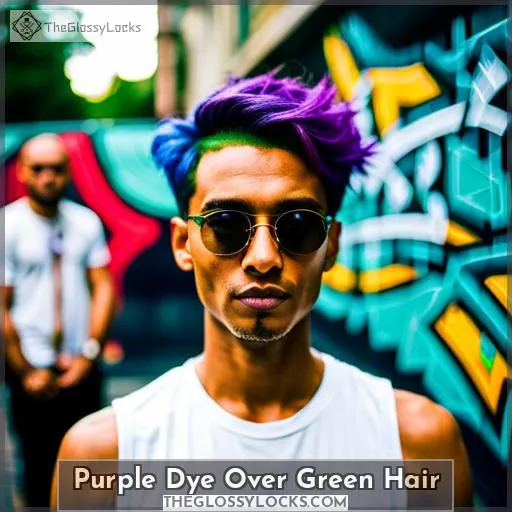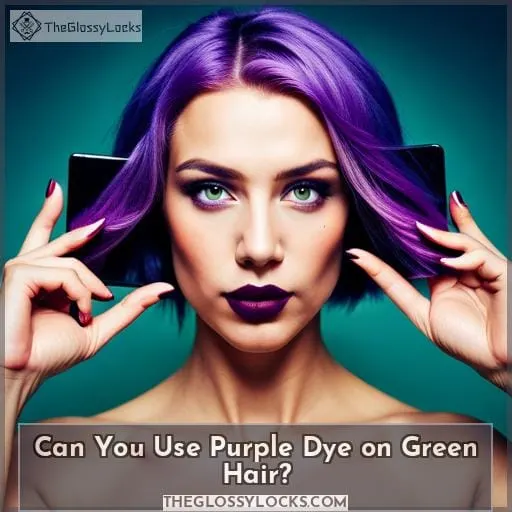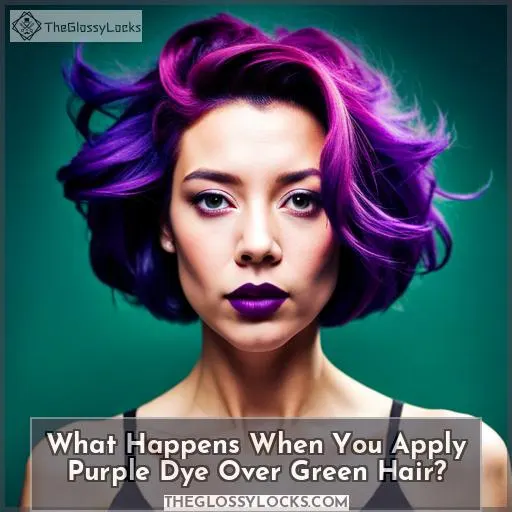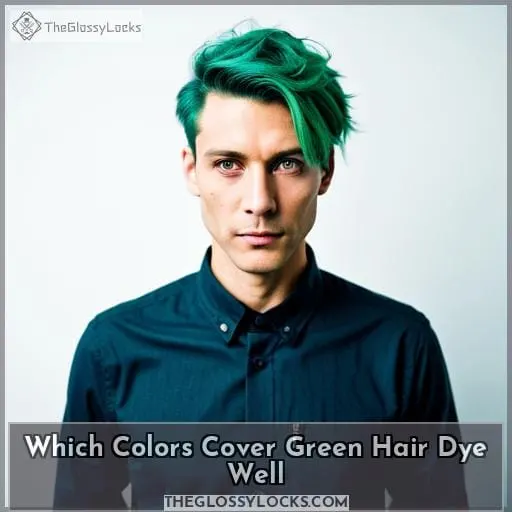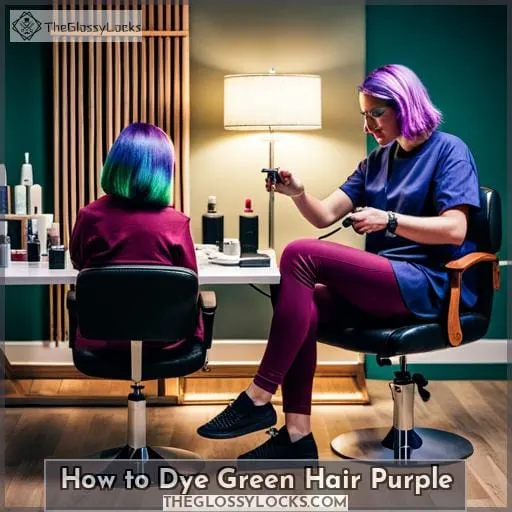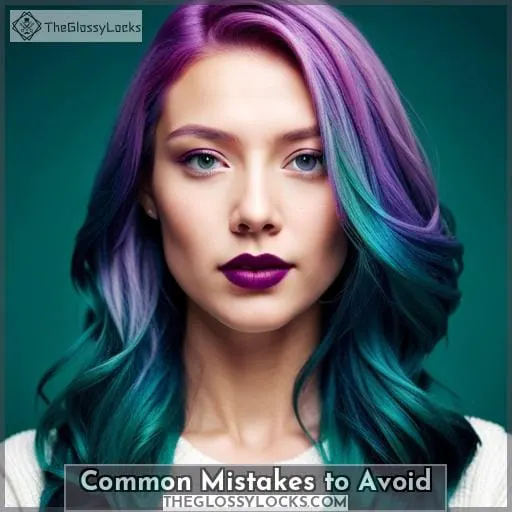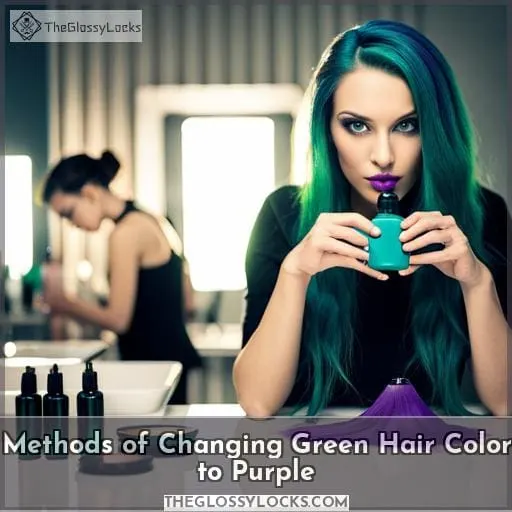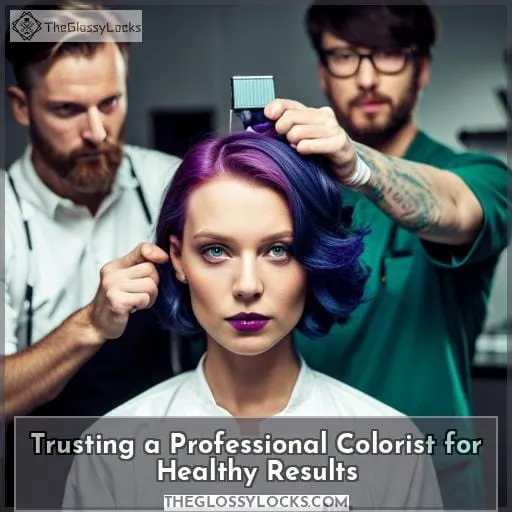This site is supported by our readers. We may earn a commission, at no cost to you, if you purchase through links.
Changing the color of your hair can be a daunting task. It’s like painting an abstract masterpiece; you have to take into account all the colors and how they should interact with each other for it to turn out just right.
But when it comes to changing green hair dye, especially using purple dye, there is more than meets the eye.
Before taking on this project yourself at home or trusting a professional colorist in their salon chair, one must understand what happens if you put purple dye over green hair and which colors cover up well before going further down that path.
Table Of Contents
- Key Takeaways
- Can You Use Purple Dye on Green Hair?
- What Happens When You Apply Purple Dye Over Green Hair?
- Which Colors Cover Green Hair Dye Well?
- How to Dye Green Hair Purple
- Common Mistakes to Avoid
- Methods of Changing Green Hair Color to Purple
- Trusting a Professional Colorist for Healthy Results
- Frequently Asked Questions (FAQs)
- How long does it take for purple dye to take effect on green hair?
- What should I do if I have previously bleached and colored green hair?
- Are there any natural methods to help change green hair to purple?
- Will purple dye completely cover up green hair?
- Is there any way to prevent hair damage when changing colors?
- Conclusion
Key Takeaways
Purple dye is five times more likely to cover green hair dye than blue. Layering strong purple dye over the current green dye can result in a natural-looking transition. Direct deposit dyes are ideal for transitioning from green to purple hair. Seeking professional assistance from a skilled colorist is recommended for drastic hair color changes to achieve desired results without damaging hair.
Can You Use Purple Dye on Green Hair?
You can use a deep shade of purple to counteract the green tones in your hair, as they are complementary colors that cancel each other out. When dyeing using this method, it’s important to understand color theory and how colors interact on the color wheel.
Using developer with any type of dye will help remove existing color and make for easier application – but be sure not to keep it on too long or you could end up damaging your hair! If you’re a novice dyer, do some research into basic color mixing before attempting anything too complicated.
Familiarize yourself with different shades of green and purple that could affect the outcome when used together.
Purple shampoo or toner is an excellent choice for those trying to get rid of yellowness from grey or white-blonde locks. However, if you want something more dramatic, then red may be better than purple since they are both complementary colors which will effectively balance each other out when used in combination on green hair.
It’s also wise to perform a strand test prior so there won’t be any surprises once everything has settled! Common mistakes include selecting wrong colors (particularly ones which don’t complement well against skin tone), coloring scalp instead only strands, leaving product in for longer than recommended time frame, etc.
To avoid all these pitfalls, it’s best to seek professional advice first, especially if bleaching is necessary beforehand – trust experts who know the newest and most efficient products minimizing damage while changing hues dramatically.
What Happens When You Apply Purple Dye Over Green Hair?
When you take a chance and mix an intense hue with your existing shade, the result could be disastrous – or delightfully different! Adding color over green hair can produce unique results that are difficult to predict.
To avoid any regrets, understanding basic color theory is vital when selecting shades of purple dye for removing green tones from tresses.
It’s important to use a deep shade of purple since red and green cancel each other out on the color wheel. Lighter shades might not provide desired outcomes while using developer may strip away too much pigment in one setting causing severe damage.
Additionally, natural methods such as apple cider vinegar or lemon juice can also help fade unwanted hues without risking further harm, although it takes longer time before achieving the wanted tone.
- Be aware of primary colors and how they interact together.
- Understand which shades will work best for covering up existing pigments.
- Utilize toners/shampoos if aiming towards a more subtle change.
- Consider consulting professional hairstylists before taking drastic steps.
- Use proper techniques like strand tests prior to coloring all strands evenly.
If attempting to go back to natural colors after having them dyed in bright hues first, then bleaching might become necessary unless opting for low maintenance options like ombre looks instead by only lightening ends slightly rather than the whole head at once.
Which Colors Cover Green Hair Dye Well?
Considering the cardinal rules of hair coloring, it’s important to understand which colors work best when trying to cover up existing green tones on your tresses. On the color wheel, red and green cancel each other out, so a deep shade of purple is typically recommended for direct application over previously dyed strands.
Although lighter shades can still be used if toning or adding subtle hues are desired, just remember that using developer may strip away too much pigment in one setting, causing severe damage! To avoid such situations, natural methods like lemon juice or an apple cider vinegar rinse can help fade unwanted pigments without risking further harm in the bleaching process.
Although this route may take longer time before achieving any noticeable changes.
For those seeking brighter results instead but wary of potential damages from bleach baths, ombre looks could be another viable option by only lightening ends slightly rather than attempting drastic transformations all at once.
Red shampoo is also a great choice for removing yellowish undertones while blue dye works well in combination with purple for covering up greens effectively, especially when combined together via a bleach bath technique initially beforehand.
Allowing professional hairstylists access to newer and better products available nowadays definitely helps minimize possible damages during coloring sessions since they know exactly what needs to be done right away, not needing lengthy preparations prior either unless dealing with extreme cases where bleaching might become necessary returning back towards natural colorations again after being saturated by bright dyes already beforehand (like emeralds/minty greens).
How to Dye Green Hair Purple
Dyeing your green hair purple is a great way to switch up your look. Firstly, choose the right shade of purple for you – think about which one will complement or contrast with your natural skin tone.
To prepare for dyeing, wash and condition your hair several days prior. On the day itself, part it into four sections before mixing up the color solution according to package instructions.
Step 1 – Choose a Purple Shade
Choose a vibrant hue to give your hair some pizzazz. You’re in for a real treat! When it comes to coloring green hair purple, understanding color theory and using the color wheel will help determine the best shade of dye.
Pre-bleaching is recommended before applying any secondary colors like purple. Do a strand test first and consider hydrogen peroxide levels when selecting shades with red pigments that can neutralize green tones more effectively than other dyes on the market today.
To create an eye-catching look, try experimenting with different hues from deep purples to bright magentas.
Step 2 – Hair Preparation
Before you start dyeing, prepare your hair by washing and conditioning it a few days prior. Apply a scalp protection cream before using braiding techniques to section off strands for tinting. If your green hair appears dull or yellow-ish, use blue shampoo or a toner from the green hair wagon website to restore shine and vibrancy.
When selecting shades of purple, use color wheel theory to ensure they work well with existing hues of green and avoid clashing colors and fading results over time. Leah Loves Hair has some great tips on this! For an extra boost, try using chemical removers designed specifically for removing unwanted color tones from dyed locks.
Step 3 – Hair Parting
Divide your hair into four sections before applying the dye, as this will help you achieve even coverage.
- Hair toning and color mixing for desired results
- Strand testing to ensure individual strands are covered in purple correctly
- Green removing products such as bleach or chemical removers can be used for outstanding results when using purple hair dye over green hair.
Depending on the current color of your green locks, select shades of purple that complement it accordingly. The recommended holding time is 20-30 minutes. However, if coloring with a dark tone like black cherry or navy blue, use caution not to leave it on too long, which could result in damage from over-processing.
Step 4 – Mix the Color Solution
Mix your color solution according to the instructions on the package. Then, get ready for a transformation! Purple toning and color mixing can help achieve desired results, so strand tests come in handy.
To change green hair to purple, overlapping dye is recommended with developer strength depending on the current shade of locks. Hair products like direct deposit dyes are ideal for this transition. Try adding purple highlights too! If using green hair dye instead of the traditional type of hair dye, use caution not to leave it on too long.
Damage from over-processing could occur. Get creative with colors and trust that you will find success.
Step 5 – Set the Time
Once everything is ready, set the timer and let your transformation begin! Color combining and bleaching advice can be helpful when choosing a shade. It’s important to consider time management as well; leaving dye in for too long can lead to hair damage.
For best results, it’s recommended to seek professional assistance from an experienced colorist – they have the skills to help you achieve your desired outcome safely. To further protect your hair, cover it with a plastic bag before applying the entire contents of the color solution evenly throughout your strands according to the instructions on the package label.
Common Mistakes to Avoid
When dyeing your green hair purple, it is important to avoid certain mistakes. Choosing the wrong color, coloring your scalp instead of just the length of your hair, keeping the color on for too long, or choosing shades that don’t complement your skin tone can all lead to an undesired outcome.
Additionally, overusing heat styling tools such as blow dryers and flat irons is not recommended when trying out new colors since they may cause further damage to already dyed locks.
Choosing the Wrong Color
Be careful when choosing the color for your hair, as selecting the wrong shade can lead to an undesired result. Common mistakes include using too strong of a dye or not bleaching prior to coloring if you’re looking for natural colors or bright shades.
It’s also important to understand color theory and how different colors interact on the wheel, such as red canceling out green and purple toning down yellow – not green! Furthermore, remember that developer is needed before overlapping with another hue, while strand tests are necessary in order to ensure the desired outcome without damaging hair strands.
Coloring Your Scalp
Avoid making the common mistake of coloring your scalp when dyeing your hair. It can be difficult to undo and may leave you with uneven results. When choosing a color, make sure to use hair care techniques such as mixing colors correctly or using developer for existing green color removal.
If you’re unsure of what shade will work best, it’s always a good idea to consult with a professional stylist or chief editor before committing.
A Joico Color Infuse Red Shampoo is also available, which works nicely on removing green dyes from the scalp area without damaging hair strands too much if used properly. Popular shades like emerald green and black are achievable but need careful consideration in terms of choice and application due to their boldness.
All in all, remember that mistakes happen, but staying educated about various colors and how they interact is key in obtaining desired outcomes while keeping damage at bay.
Keeping the Color on for Too Long
Never leave the dye in your hair longer than necessary, or you risk ending up with a brassy hue that is hard to reverse. Mixing colors correctly and performing a strand test beforehand are essential steps to avoid mistakes.
To fade green hair, natural methods like apple cider vinegar or lemon juice can be used, as well as dark purple color if desired. Taking into account the length of your hair is also important when selecting additional products such as developer for permanent shade results and the best colors for covering green tones.
Choosing Shades That Don’t Compliment Your Skin Tone
When selecting shades for dyeing your hair, consider what color complements your skin tone to ensure the best results. Hair color science suggests that purple shampoo or toner can help remove yellowness from grey or white-blonde hair.
Red and green are complementary colors and cancel each other out, so a dark brown or black shade may be an excellent option when covering green hair completely.
Furthermore, blue dye is better than purple for coloring over it, while orange and red will not likely yield desired results on their own without a medium-strong developer to aid in removing pigments first.
Overusing Heat Styling Tools
Avoiding heat styling tools is key to maintaining healthy hair when changing colors, especially after using purple dye over green.
- Take a break from heat-styling tools and let your hair recover before attempting part color.
- Use styling products specifically designed for colored or chemically treated hair.
- Wrap wet strands in an old t-shirt instead of using drying towels to avoid split ends.
Additionally, use the opposite end of the color wheel when selecting complementary shades, such as blonde with red or black with blue, so that they don’t cancel each other out.
Following these simple steps can help keep your mane looking vibrant while preventing any potential damage due to overusing heated devices.
Methods of Changing Green Hair Color to Purple
Changing your green locks to purple doesn’t have to be difficult; try overlapping the existing color with an intense shade. Before starting, it’s essential to preserve hair health by using a deep conditioner and avoiding heat styling tools for at least 24 hours before dyeing.
Next, test the color dye on a small strand of hair first to ensure that you achieve the desired result without damaging your entire head of hair. When considering different dyeing techniques, remember that colors interact differently based on their position on the color wheel theory.
To make purple stand out more against green pigments in your hair, use an intense shade like plum or violet and mix it with a medium-strong developer for better penetration into strands.
| Base Color | Strong Shades |
|---|---|
| Blonde | Plum |
| Light Brown | Lavender |
| Dark Brown | Violet |
Green is known as one of the most challenging colors to remove from hair because its pigment has solid staying power. Fading green away before applying any other hue is highly recommended if possible since this will give you more control over how much new pigment gets deposited onto each strand while preventing unwanted mixing between old and new shades.
To make transitioning from green easier when trying out different colors such as emerald or olive tones (which also require dark bases), consider investing in efficient products specifically designed for preserving healthy dyed locks like toners or shampoos formulated with natural oils and vitamins A-E-C-K complex.
Remember to always rinse thoroughly after coloring!
Trusting a Professional Colorist for Healthy Results
If you’re looking to make a drastic change in your hair color, it’s best to trust an experienced professional colorist.
For instance, if transitioning from green back to yellow blonde is desired, bleaching may be necessary as well as toners for removing any yellowness that may still remain after lightening.
Here are some benefits when trusting skilled professionals with dyeing:
- They understand what needs to happen prior – prepping tresses by using conditioner before dyeing helps keep locks healthy & vibrant
- Professionals have access to advanced techniques such as two-step dying where a whole different shade is applied first before finally depositing the desired hue onto strands
- Protects against oversaturation – keeping pigment on for short periods prevents deep pigmentation while preserving existing tones already present in one’s mane
- Results look more natural – skillful application ensures even distribution throughout the head, avoiding splotchy patches all over the scalp area
Achieving great colors requires patience; take time deciding on particular shades that work best with one’s skin tone & texture since certain hues require dark bases while others don’t.
Frequently Asked Questions (FAQs)
How long does it take for purple dye to take effect on green hair?
When changing green hair color to purple, it typically takes up to thirty minutes for the dye to take effect. However, this may vary depending on the shade of green and type of developer used. It is recommended to perform a strand test before application as a precautionary measure.
Use imagery that resonates with your audience, such as vivid colors blending together or lightening effects taking shape.
What should I do if I have previously bleached and colored green hair?
If you have previously bleached and colored your hair green, it is recommended that you seek the assistance of a professional hairstylist. On average, women spend $50,000 on beauty services throughout their lifetime, making this an essential step in maintaining healthy hair.
A colorist can provide advice on which products are best suited to your individual needs and help you achieve your desired results without causing damage to your hair.
Are there any natural methods to help change green hair to purple?
To naturally change green hair to purple, you can try using a strong purple dye over the current green dye. By layering the two colors, you can achieve a striking color combination that makes a bold statement.
However, it is important to conduct a strand test beforehand and use a developer for optimal results.
Will purple dye completely cover up green hair?
Yes, purple dye will cover up green hair. It is a powerful combination that can result in stunning outcomes. However, it is essential to be aware of the color wheel and how colors interact to ensure the desired result.
Experimenting with different shades and using a good developer can help achieve the desired outcome.
Is there any way to prevent hair damage when changing colors?
Changing colors can be a daunting task, much like climbing a mountain. To prevent damage, it is best to enlist the help of an experienced colorist who knows how to navigate this tricky terrain. They will use their expertise and the latest hair products to safely transition your hair from one shade to another while preserving its health.
Conclusion
Overall, purple dye is an effective way to change green hair to purple. It is important to know which colors cover green hair dye the best and to prepare your hair before dyeing. A professional colorist is the best way to get the desired color and maintain healthy hair.
Additionally, a professional colorist knows the newest and most efficient hair products to minimize hair damage.
An interesting statistic to note is that purple hair dye is five times more likely to cover green hair dye than blue. With the right knowledge and preparation, you can successfully dye green hair purple and rock your new look.

